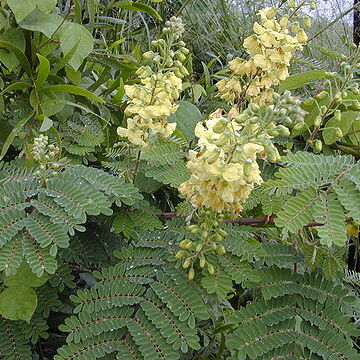Sprawling shrub or climber to 20 m. Bark rough at base, smoother and cream-green above. Stems prickly, densely pubescent. Leaves to 40 cm long (fide Richardson et al. 2016: 281): stipules ovate, acuminate, pubescent both sides; petiole 3–8 cm long; rachis prickly; pinnae 4–10 pairs; stipellae prickle-like; leaflets 5–12 pairs, oblong to ovate, 6–20 mm long, 2–6 (–8) mm wide, obtuse, discolorous, pubescent both sides. Racemes terminal, simple, 15–35 cm long; rachis pubescent; pedicels 15–25 mm long; bracts lanceolate, 7–9 mm long, hirsute, caducous; flower reflexed at apex of pedicel. Sepals oblong, 9–10 mm long. Petals ± orbicular, 10–15 mm long, white to pale yellow; uppermost petal smaller and narrower. Stamens 10–16 mm long, woolly in lower half; anthers 1.7 mm long. Pistil 15–20 mm long, hairy in lower two-thirds; stigma cup-like; ovules 8–10. Pod oblong with prominent thorn-like beak, straight or gently curved, swollen over seeds, 6–10 cm long, 2.3–2.5 cm wide, dehiscent, prominently veined on one side, brown, pubescent. Seeds 4–9, globular, 6–10 mm diam., brown and black. See also Green (1994: 170), as Caesalpinia decapetala.
Climbing or straggling bushy shrub, up to 8 m high; often forming dense thickets; stems densely clothed with short brownish pubescence when young, armed with scattered, spreading prickles. Leaves finely fulvous-pubescent, 120-350 mm long, rachis armed with hooked prickles below, often in pairs; petioles eglandular, armed with hooked prickles below. Pinnae 4-11 pairs. Leaflets 8-13 pairs per pinna, oblong to somewhat obovate-oblong, pubescent on both surfaces. Stipules asymmetrically ovate, acuminate, margins undulate. Inflorescences of axillary and terminal racemes, 100-400 mm long. Flowers pale yellow. Flowering time Oct.-Feb. Pod brown, compressed, unarmed, dehiscing along upper suture.
A woody climber. It has many prickles. The bark is dull red. The branches and leaves have hairs and prickles. The leaves are 20-30 cm long with 3-10 pairs of pinnae or leaflets. These have 8-12 pairs of leaflets. The pods are brown and 6-12 cm long by 3 cm wide. There are 6-9 seeds. These are oval and 11 mm long by 6 mm wide.
Climbing or straggling bushy shrub, up to 8 m high. Stems armed. Leaves 2-pinnate; leaflets (8-)10-20 mm long, without gland-dots. Stipules asymmetrically ovate, 4-20 x 2-8 mm. Pods 60-95 mm long. Flowers pale yellow.


